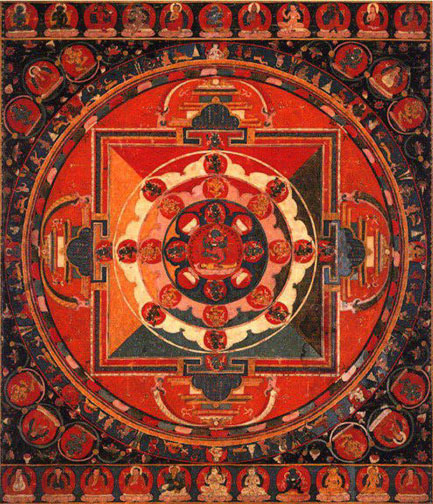
Buddhakapala Mandala
The deity Buddhakapala, "Skullcup of the Buddha," presides over this
mandala of twenty-five deities.1 The wrathful god embraces his consort
Citrasena, while his four other hands hold the skullcup, chopper,
ceremonial staff and hand drum. He assumes the
dancer's pose (ardhaparyanka) upon a corpse which is itself supported by
a lotus borne by the sun.
Attendant deities in the mandala's first circle appear on the petals of
an open lotus: Sumalini (E), Kapalini (N), Bhima (W) and Durjaya (S).2
Skullcups supported by lotuses mark the four intermediate points of the
compass. The second circle of deities
includes: Subhamekhala (E), Rupini (N), Vijaya (W), Kamini (S), Kapalini
(NE), Mahadadhi (SE), Karini (SW) and Marani (NW). The third circle
includes: Tarini (E), Bhimadarsana (N), Sudarsana (W), Ajaya (S), Subha
(NE), Astaraki (SE), Kalaratri (SW) and M
ahayasa (NW). Sundari (E), Vajrasundari (N), Subhaga (W) and
Priyadarsana (S) guard the mandala's four gates.
This mandala was once part of a set of mandalas illustrating
Annuttarayoga teachings. These teachings were transmitted by an
historical lineage illustrated in the painting's top and bottom
registers, and including the four historical figures encircled by
scrolling vines just outside the mandala circle.3 The lineage begins
with the celestial Buddha Vajradhara and includes Indian masters such as
Nagarjuna (act. second century A.D.) and prominent Tibetan masters of
the eleventh and twelfth centuries, such
as the famed translator Marpa (mar-pa, 1012-96).